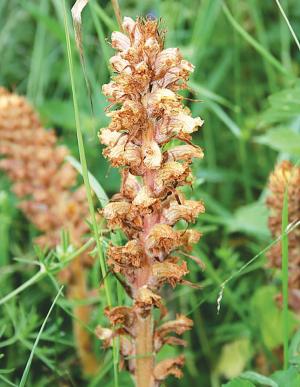Researchers Battle Parasitic Weeds
 ✖  |
A team of researchers at the University of California, Riverside, has identified a promising weapon in the global fight against parasitic weeds. Orobanchaceae weeds invade crops and strip essential nutrients from the root system. With nearly 200 species in the family and the ability to produce as many as 50,000 tiny seeds per plant, they’re serious threats, devastating the crops they infest.
“These parasites are most problematic in sub-Saharan Africa, the Mediterranean region and Asia,” says David Nelson, Plant Biologist at the University of California, Riverside (UC Riverside). “U.S. agriculture is much less impacted by these weeds, in part because we’re so aggressive about quarantine and control when they pop up.”
That said, the Orobanchaceae, commonly known as witchweeds, have been found in California, and those often called broomrapes have been found in North and South Carolina. The California variety poses a threat to the $1.5 billion processing tomato industry. If growers discover it in their fields and report it to the state, they’re required to destroy the field before harvest.
Broomrapes made a serious invasion in the Carolinas during the 1950s. By 1956, they had infested nearly half a million acres. Eradication efforts have been largely successful, and by 2015, the infestation was reduced to around 1,300 acres. Control efforts are ongoing.
Nelson and the UC Riverside research team are working with a class of hormones called strigolactones. Potential host plants naturally produce these hormones to regulate growth and encourage the growth of beneficial fungi. However, the parasitic seeds can lie dormant in the soil for up to 10 years until their host plant releases the hormones.
“The idea is to trick parasitic weed seeds into germinating in the absence of a host by treating the soil with strigolactones or a similar compound that can stimulate germination,” explains Nelson. “Without successfully attaching to a host, the parasite seedling runs out of energy and dies in a few days.”
Nelson describes it as weed suicide. The problem with this approach is that strigolactones are complicated molecules that are difficult and expensive to synthesize. They’re also generally unstable in water.
The research team, led by Professor Yanran Li, now at UC San Diego, developed a process to produce the hormones using bacteria and yeast. This allows them to study the hormones and potentially produce large amounts of them. They also identified the genes that make them.
The research opens the door to a deeper understanding of the hormones and how they can be adapted and used. It also applies to a better understanding of other plant enzymes.
In addition to soil application, possible uses include rotation cropping with a non-host crop that produces strigolactones, which will stimulate parasitic weed seed germination.
The researchers are evaluating the weed suicide strategy to see if it’ll work in real-world fields.
“We’re testing whether we can fine-tune the chemical signal to be even more effective,” Nelson said. “If we can, this could be a game-changer for farmers battling these weeds.”
Contact: FARM SHOW Followup, Prof. David Nelson, Nelson Lab, University of California, 5488 Boyce Hall, 3401 Watkins Dr., Riverside, Calif. 92521 (ph 951-827-4397; david.nelson@ucr.edu; https://nelsonlab.ucr.edu).

Click here to download page story appeared in.
Click here to read entire issue
Researchers Battle Parasitic Weeds
A team of researchers at the University of California, Riverside, has identified a promising weapon in the global fight against parasitic weeds. Orobanchaceae weeds invade crops and strip essential nutrients from the root system. With nearly 200 species in the family and the ability to produce as many as 50,000 tiny seeds per plant, they’re serious threats, devastating the crops they infest.
“These parasites are most problematic in sub-Saharan Africa, the Mediterranean region and Asia,” says David Nelson, Plant Biologist at the University of California, Riverside (UC Riverside). “U.S. agriculture is much less impacted by these weeds, in part because we’re so aggressive about quarantine and control when they pop up.”
That said, the Orobanchaceae, commonly known as witchweeds, have been found in California, and those often called broomrapes have been found in North and South Carolina. The California variety poses a threat to the $1.5 billion processing tomato industry. If growers discover it in their fields and report it to the state, they’re required to destroy the field before harvest.
Broomrapes made a serious invasion in the Carolinas during the 1950s. By 1956, they had infested nearly half a million acres. Eradication efforts have been largely successful, and by 2015, the infestation was reduced to around 1,300 acres. Control efforts are ongoing.
Nelson and the UC Riverside research team are working with a class of hormones called strigolactones. Potential host plants naturally produce these hormones to regulate growth and encourage the growth of beneficial fungi. However, the parasitic seeds can lie dormant in the soil for up to 10 years until their host plant releases the hormones.
“The idea is to trick parasitic weed seeds into germinating in the absence of a host by treating the soil with strigolactones or a similar compound that can stimulate germination,” explains Nelson. “Without successfully attaching to a host, the parasite seedling runs out of energy and dies in a few days.”
Nelson describes it as weed suicide. The problem with this approach is that strigolactones are complicated molecules that are difficult and expensive to synthesize. They’re also generally unstable in water.
The research team, led by Professor Yanran Li, now at UC San Diego, developed a process to produce the hormones using bacteria and yeast. This allows them to study the hormones and potentially produce large amounts of them. They also identified the genes that make them.
The research opens the door to a deeper understanding of the hormones and how they can be adapted and used. It also applies to a better understanding of other plant enzymes.
In addition to soil application, possible uses include rotation cropping with a non-host crop that produces strigolactones, which will stimulate parasitic weed seed germination.
The researchers are evaluating the weed suicide strategy to see if it’ll work in real-world fields.
“We’re testing whether we can fine-tune the chemical signal to be even more effective,” Nelson said. “If we can, this could be a game-changer for farmers battling these weeds.”
Contact: FARM SHOW Followup, Prof. David Nelson, Nelson Lab, University of California, 5488 Boyce Hall, 3401 Watkins Dr., Riverside, Calif. 92521 (ph 951-827-4397; david.nelson@ucr.edu; https://nelsonlab.ucr.edu).
To read the rest of this story, download this issue below or click
here to register with your account number.







